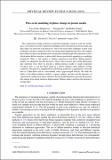Pore-scale modeling of phase change in porous media
Author(s)
Cueto-Felgueroso, Luis; Fu, Xiaojing; Juanes, Ruben
DownloadPhysRevFluids.3.084302.pdf (8.222Mb)
PUBLISHER_POLICY
Publisher Policy
Article is made available in accordance with the publisher's policy and may be subject to US copyright law. Please refer to the publisher's site for terms of use.
Terms of use
Metadata
Show full item recordAbstract
The combination of high-resolution visualization techniques and pore-scale flow modeling is a powerful tool used to understand multiphase flow mechanisms in porous media and their impact on reservoir-scale processes. One of the main open challenges in pore-scale modeling is the direct simulation of flows involving multicomponent mixtures with complex phase behavior. Reservoir fluid mixtures are often described through cubic equations of state, which makes diffuse-interface, or phase-field, theories particularly appealing as a modeling framework. What is still unclear is whether equation-of-state-driven diffuse-interface models can adequately describe processes where surface tension and wetting phenomena play important roles. Here we present a diffuse-interface model of single-component two-phase flow (a van der Waals fluid) in a porous medium under different wetting conditions. We propose a simplified Darcy-Korteweg model that is appropriate to describe flow in a Hele-Shaw cell or a micromodel, with a gap-averaged velocity. We study the ability of the diffuse-interface model to capture capillary pressure and the dynamics of vaporization-condensation fronts and show that the model reproduces pressure fluctuations that emerge from abrupt interface displacements (Haines jumps) and from the breakup of wetting films.
Date issued
2018-08Department
Massachusetts Institute of Technology. Department of Civil and Environmental EngineeringJournal
Physical Review Fluids
Publisher
American Physical Society
Citation
Cueto-Felgueroso, Luis et al. "Pore-scale modeling of phase change in porous media." Physical Review Fluids 3, 8 (August 2018): 084302 © 2018 American Physical Society
Version: Final published version
ISSN
2469-990X
2469-9918